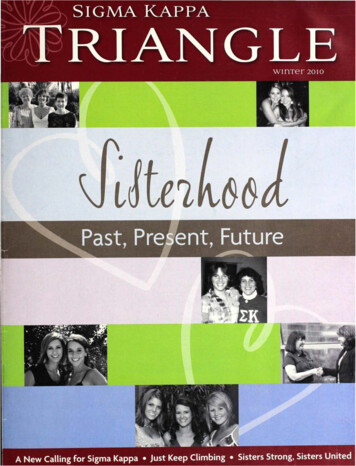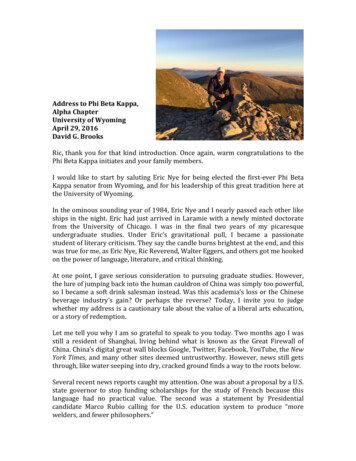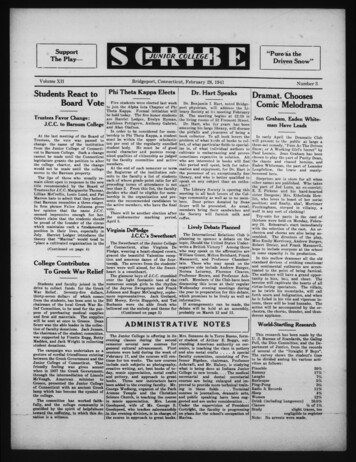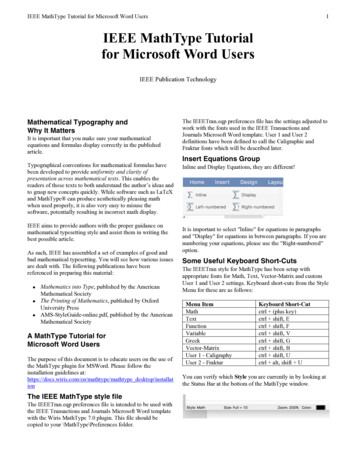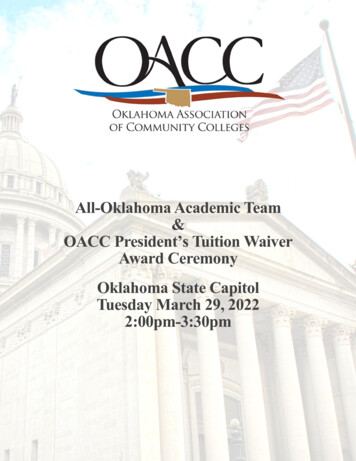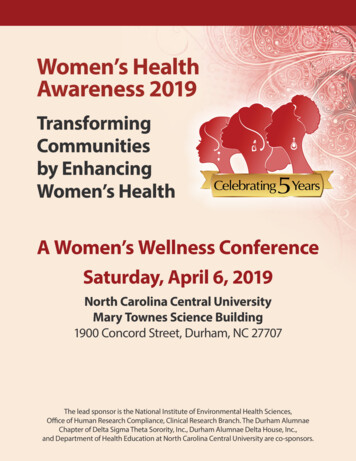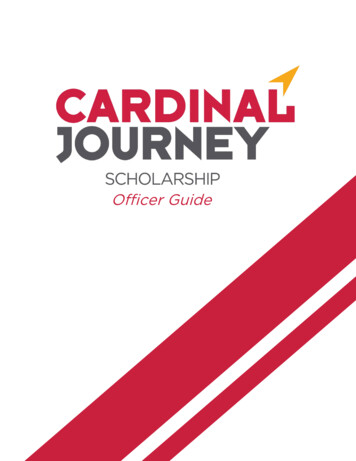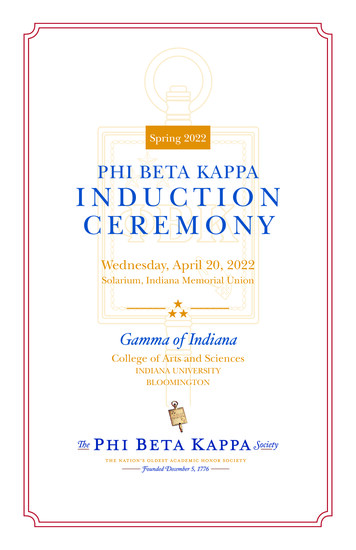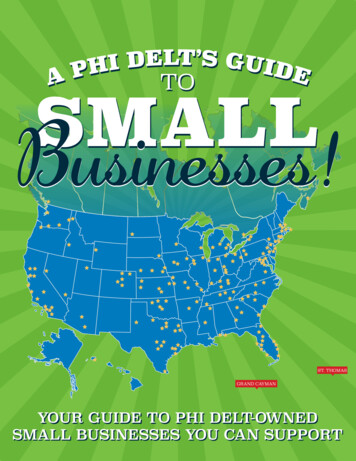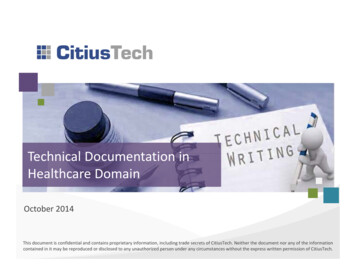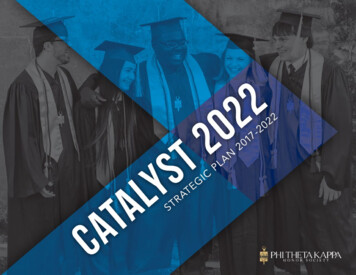
Transcription
S T R AT E G I C P L A NTA B L E O F C O N T E N T SLetter from the President and CEO. 2Environmental Analysis. 3Student Challenges.4Transfer and Workforce Preparation.8Chapters and Regions.11Communications.14Enrollment and Membership Trends.17Alumni Chapters and Engagement.22PHI THETA KAPPA MISSIONThe mission of Phi Theta Kappa is to recognize academic achievement of college students and to provideopportunities for them to grow as scholars and leaders.Society Commitments. 25Commitment 1: Strengthen Pathways to Completion, Transfer and Employment.26Commitment 2: Increase Transparency, Awareness and Support with New Communications.29PHI THETA KAPPA VISIONCommitment 3: Strengthen Chapters and Regions with a Primary Focus on the Society Mission.32Phi Theta Kappa’s vision is to make the benefits of membership accessible to all deserving college students.Commitment 4: Increase Access to Membership by Closing Equity and Inclusion Gaps.35Commitment 5: Leverage Society Network by Supporting Alumni Engagement.38Strategic Plan At-A-Glance. 41Phi Theta Kappa Board of Directors. 42Phi Theta Kappa Foundation Board of Trustees. 43Phi Theta Kappa Executive Council. 44STRATEGIC PLAN1
S T R AT E G I C P L A NLETTER FROM THE PRESIDENT AND CEOSince its humble beginnings on the campus of Stephens College in Missouri nearly a century ago, with just sixmembers, Phi Theta Kappa has grown to 1,285 chapters on college campuses in all 50 of the United Statesand around the world. More than 3.2 million students have been inducted since 1918, with approximately130,000 students inducted annually, making Phi Theta Kappa a true catalyst among members and colleges.Throughout its history, Phi Theta Kappa has held true to its mission of opening doors for community collegestudents. Through recognition, innovative programming, scholarship and fellowship, Phi Theta Kappa haschanged lives. As we move closer to the milestone of celebrating a century, it is time to reflect on the work wehave done, the work we are currently doing and the work we need to do to remain relevant and meaningfulwithin the higher education landscape.We have spent the past year conducting an in-depth environmental scan of the issues facing community colleges and have determinedtheir anticipated impact on the Society. Additionally, we have spent significant time engaged in meaningful conversations with ourconstituents — community college presidents, advisors, current members, alumni and staff — in an effort to identify how we can betterfulfill the mission of the Society. The result is Catalyst 2022.This research-based, five-year plan represents practical, operational strategies designed to strengthen Phi Theta Kappa at all levels —beginning with the member experience and extending to the chapter and regional levels. This plan is further designed to bolster ourrelationships with community colleges, as we align our priorities with theirs in an effort to support student success in communities and oncommunity college campuses throughout the world.Although much good work has already been done, Phi Theta Kappa is truly in its infancy in its ability to transform the lives of its members.This plan will guide us, as we work to sharpen the delivery of our mission and continue to be a catalyst for the members we serve.Lynn Tincher-Ladner, Ph.D.President and CEOPhi Theta Kappa Honor Society2CATALYST 2022ENVIRONMENTAL ANALYSIS3
E N V I R O N M E N TA L A N A LY S I SSTUDENT CHALLENGESSince the early 2000s, community colleges have faced significantThe unmet need of low-income students is a very real crisis — creatingdeclines in state-supported funding of community colleges. While therealmost impossible barriers. Among these issues are homelessness and foodhas been a flurry of philanthropy and community leaders involved in solvinginsecurity. Over half of all community college students face some level offunding issues, these efforts have been highly localized. Policy makers, infood insecurity, and nearly 13% experience some form of homelessnessgeneral, have chosen to not raise taxes to meet the funding needs of ourwhile a community college student. For these students, becoming acolleges; as a result, the budget shortfalls have been passed along to themember of Phi Theta Kappa is financially out of reach.people most in need — the students.Low-income community college students face the additional barrier of studentSince 2000, the median tuition at public two-year colleges has increasedengagement. It is widely accepted that there is a connection between student142%, and during that same time, Society membership fees have increasedengagement and favorable educational outcomes; however, low-income57%. These access challenges have been reflected both in communitystudents, who are required to work to make ends meet, have less time tocollege enrollment declines and in those joining Phi Theta Kappa. Wagesconnect with peers and professors and to take part in social and academicand student financial aid subsidies have not kept pace with these andactivities that encourage student success like Phi Theta Kappa.other increases.Percent of Total Community College Attendance Covered by Pell GrantsDespite the lower cost of community college, federal Pell Grant support forE N V I R O N M E N TA L A N A LY S I SSTUDENTCHALLENGEScommunity college students is critical, specifically because many communitycollege students are low income. When Pell Grants were originally established,they covered a much higher percentage of tuition, leaving students with someamount of cushion to cover the other costs associated with being a student — thingslike childcare, housing, transportation and food.Today, the cost of education has risen so much that the opposite is in effect,99%62%52%leaving many students unable to cover the cost of community college tuition,much less the cost of living. Today, the maximum Pell Grant covers only 52% ofthe total cost of attendance.4CATALYST 20221979 - 802010 -112013 -14ENVIRONMENTAL ANALYSIS5
E N V I R O N M E N TA L A N A LY S I SNumbers of High-Achieving, Low-Income StudentsUnable to Join Phi Theta Kappa Due to Membership CostsPTK FOCUS GROUP HIGHLIGHTSBased on community college Pell Grant recipients with GPAs greater than 3.5 (NCES and Phi Theta Kappa data 0601,0005,1002,8008,100 9002,100STUDENT CHALLENGES7,300600 4,9001,8004,600400TRUTHTRENDNEW IDEAFocus groups across all constituents —A rising number of colleges are usingAdvisors and colleges need a robust way toeasily discount the costs of membership.college presidents, advisors, regionalfundraising and foundation efforts tocoordinators and students — stressed thesubsidize membership fees for deservingimportance of keeping membership feesstudents who cannot afford membership.as low as possible.3,6003,8004,000PTK DATA 0005006CATALYST 20221,200Financial barriers to membershipNearly 300 chapters have noare the primary reason students do nottype of budget support from theiraccept membership.college administration.Using Pell recipients as a proxy, an estimated200,000 low-income students are eligibleannually to join Phi Theta Kappa but cannotafford to accept membership.ENVIRONMENTAL ANALYSIS7
E N V I R O N M E N TA L A N A LY S I ST R A N S F E R A N D W O R K F O R C E P R E PA R AT I O NScholarships provided directly through the Phi Theta Kappa Foundation’s fundraising efforts are largelyCommunity College Degree and Certificate Productiongeared toward members pursuing a bachelor’s degree. Even game-changing transfer scholarships such asthe Jack Kent Cooke Foundation (JKCF) Community College Transfer Scholarship are, by and large, soughtafter and won by Phi Theta Kappa members — in recent years, more than 88% of JKCF scholars havebeen Phi Theta Kappa members. As a result, the Society has come to be known as the center of transferscholarship opportunities for high-achieving community college students within the United States.Pathways to bachelor’s degree completion have been a priority of the Society for a very long time and26%TransferPreparation74%should continue to be so; however, Phi Theta Kappa must also determine its role in equipping memberswith resources and skills needed to transition directly into the workforce. While the Society offersWorkforcePreparationprofessional development for employment (soft skills) training, it provides very few financial subsidies forstudents who plan to enter the workforce immediately following community college. Because our focusand benefits have been largely focused on transfer students, Phi Theta Kappa has failed to attract thelargest portion of the nation’s community college students.Our nation’s community colleges produce three times more associate degrees and certificates to preparestudents for jobs in the workforce than degrees designed for transfer. Phi Theta Kappa’s membership isthe opposite of that, with only one in four members headed directly into the workforce after communitycollege. The percentage of career-ready degrees is likely to continue to increase over the coming years.Phi Theta Kappa Membership by Degree TypeBy 2020, it is estimated that 65% of all jobs in the economy will require a post-secondary degree or training.E N V I R O N M E N TA L A N A LY S I STRANSFER ANDWORKFORCEP R E PA R AT I O NPhi Theta Kappa is well-known for its work in transfer preparedness, anAt current rates of degree completion, the United States will be short 5 million qualified workers in fieldsimportant part of the community college mission. For the past 46 years, Phi Theta Kappaincluding healthcare, community services and STEM. Of those, the most difficult jobs to fill will be thosehas advocated for transfer scholarships from public and private four-year colleges andof skilled trade workers — programs that only exist in community colleges. The nation is calling uponuniversities. Through CollegeFish, members have access to over 37 million in transfercommunity colleges to focus on degree completion in those programs that lead students directly to work.scholarships annually from over 750 four-year partners. The development of CollegeFishPhi Theta Kappa must also respond to this growing need by finding ways to provide these students withrepresents a significant financial investment in the student exploration of transfer. Inmember benefits equivalent to those available to our transfer-bound students.partnership with the Gates Foundation, Phi Theta Kappa invested more than 5 million ate the transfer scholarship database for our members.70% of the time, the costs of industry certification exams are passeddirectly on to the student.— Lumina FoundationReport on Embedding Industry and ProfessionalCertifications within Higher Education8CATALYST 2022ENVIRONMENTAL ANALYSIS9
E N V I R O N M E N TA L A N A LY S I ST R A N S F E R A N D W O R K F O R C E P R E PA R AT I O NPTK FOCUS GROUP HIGHLIGHTSTRUTHTRENDNEW IDEAThere will be an increased emphasis onStudents want more scholarshipsCollege presidents are considering othercareer and technical educationand benefits available to them while they arehonor societies on campus to providein the community college sector.enrolled at the community college. Collegemore focused benefits for career andtechnical students.College presidents believe that Phi Thetapresidents want Phi Theta Kappa to valueKappa should respond to this and, like thecareer and technical students as much asschools they serve, have deepertransfer students.partnerships with business and industry.PTK DATA POINTSTop 5 Majors AmongPhi Theta Kappa MembersE N V I R O N M E N TA L A N A LY S I SPhi Theta Kappa exists on nearly every community college campus inthe United States. The success and growth of Phi Theta Kappa for theNursingOnly 250,000 in scholarship moneyThree out of every four members transferis available from Phi Theta Kappa toto a four-year college or university.Liberal Arts –General EducationBusinessCHAPTERS ANDREGIONSpast century has resulted in the largest and strongest student organizationin higher education — with a 92% success rate among its members. Thereare over 1,200 dissertation studies on Phi Theta Kappa — definitivelypointing to the added value of Phi Theta Kappa to student success.students while enrolled exclusively at theassociate-degree level.10CATALYST 2022EducationSocial SciencesENVIRONMENTAL ANALYSIS11
E N V I R O N M E N TA L A N A LY S I SE N V I R O N M E N TA L A N A LY S I SCHAPTERS AND REGIONSBut like many organizations, chapters have a great deal of variability inCounts of Chapters by Performance Levelstheir success. While some chapters, year after year, flourish in the areas ofmembership and programming, others do not. Research has identified threeprimary factors contributing to chapter success: Advisor Engagement – The average length of service for a Phi ThetaKappa advisor is three years. While there is a great deal of variation withmany having served much longer, we often lose new advisors just asthey are beginning to understand the role. Administrative Support – Chapters that do not receive financialsupport from their colleges are statistically less likely to successfullyengage in Society programming. Lack of financial support makes itdifficult for students to concentrate on the Society’s co-curriculumlearning programs, and chapters spend a great deal of time onSociety’s 29 regions also vary greatly in their regional programmingefforts. Our studies show that strong and comprehensive regionalevents and programs have a positive impact on advisor, student andPTK FOCUS GROUP ing activities. Regional Engagement – Similar to the chapters they serve, theCHAPTERS AND REGIONS100138TRENDNEW IDEAAdvisors and students find a great dealNew advisors struggle for two to almostAdministrative awards should be modifiedof value added by participating in Societythree years before they fully understand howto provide more ongoing recognition ofprograms; however, students and advisorsto facilitate chapter success — particularlycollege presidents and other administratorswant more guidance and education forwith Society programming.who are continuously supportive of thetheir project preparation. Chapters alsoSociety. Recognition of college trustees waswant more feedback on how to makealso recommended.improvements for the next ter success. Providing a consistent and quality student experienceat the regional level is vital to the success of the Phi Theta Kappamission.Based on achievement rankings of Phi Theta Kappa chapters, 36% of chaptersWe believe both the Honors in Action projectare considered high-performing, 11% are considered mid-performing andand College Project are important and valuable46% are considered low-performing. Even though the Society has rigorousstandards for chapters, these trends should be in reverse.For the past year, the Society has made initial steps to strengthen our regionsby providing financial support for regional programming, website developmentand events. A regional leadership summit was held in Jackson during the fallof 2016 to gain valuable insight for the strategic plan, review Hallmark awardstructure and discuss improvements to Convention.12PTK DATA POINTBased on Five Star Chapter Plan ratings from 2015.Low-Performing 0-1 Star Levels; Mid-Performing 2-3 Star Levels;and High-Performing 4-5 Star Levels.CATALYST 2022Being a new advisor, Honors in Action is still sort of a mystery toprojects to complete with students when theme. I assume this is due to a lack of experience, but I hope tochapter is active. We are working on revivinghave additional training this year at the Convention. Honors inour chapter, but it will take several years.”Action is definitely a hurdle my chapter has yet to overcome.Nearly all low-performing chapters failto be engaged on the college level,and almost none attend annual events.— Phi Theta Kappa Chapter Advisor— Phi Theta Kappa Chapter AdvisorENVIRONMENTAL ANALYSIS13
E N V I R O N M E N TA L A N A LY S I SC O M M U N I C AT I O N SIn some cases students may not receive membership invitations, and advisors mayThis past year, Phi Theta Kappa has worked to improve its social medianot be receiving information about important deadlines and announcements.presence. We have also learned that members, advisors and presidents preferSubsequent communications to members could also be compromised as collegesdifferent types of social media channels. Younger members prefer Instagramare continuously changing their technology infrastructures that may accidentallyand SnapChat, while advisors and non-traditional students prefer Facebook, andexclude Phi Theta Kappa emails. The Society’s heavy reliance on email ispresidents prefer Twitter.becoming increasingly problematic. Email open rates for higher education are lowOver the past year, we have strengthened communications with college presidents— only 17% with an 8% bounce-back rate.by creating the Presidential Advisory Board, a 35-member board to assist inAll constituent groups — staff, alumni, members, presidents and advisors —communicating Society priorities within their respective states. Beginning inidentified communications as a major weakness of the Society. This is further2014, chapter report cards provide assessment metrics at the state, regionalconfirmed by low rates of membership acceptance and low email-open ratesand international levels so presidents and advisors can compare the progressamong constituents. Over the past year, the Society has worked to address theseof their chapter to others. While these efforts and others have helped improvecommunication barriers through several initiatives. A mobile-responsive websitecommunications, there is a significant amount of work to be done and especiallywas introduced, and information about Phi Theta Kappa, including the ability towith educating new presidents, advisors and members.accept membership, are now available on all mobile devices. The Reach newsblog was launched as a first step to evolving Phi Theta Kappa away from itsextremely low open-rate e-newsletter communication.PTK FOCUS GROUP HIGHLIGHTSThe general landscape of communications with students at community colleges isE N V I R O N M E N TA L A N A LY S I Scomplex and uneven. Some schools rely heavily on school-issued email addresses,others do not. Some schools leverage social media, others use text messages, andsome make important announcements available within their learning managementC O M M U N I C AT I O N Ssystems. Third-party communications are even more challenging as many collegeshave sophisticated SPAM filters that may block incoming communications fromoutside organizations. Additionally, FERPA protections of student information make itvirtually impossible to use targeted messaging to students without the assistance ofthe colleges themselves, which are FERPA exempt.TRUTHTRENDNEW IDEAMembers want a phone application withAlumni are concerned with the lack ofPresident focus groups reported theirprescriptive functionality to search forcommunication, and there is no informationmarketing departments would assist inscholarships and other features.specific to alumni on the Society website.awareness and recruitment efforts if toolswere provided by Phi Theta Kappa.14CATALYST 2022ENVIRONMENTAL ANALYSIS15
E N V I R O N M E N TA L A N A LY S I SC O M M U N I C AT I O N SPhi Theta Kappa Members Social Media Presence68%73%Website Usage18%51%of members use the website as the maincommunication to learn about Phi Theta Kappabenefits, events and programs39%E N V I R O N M E N TA L A N A LY S I SIn the fall of 2010, United States community college enrollment hitof advisors use the website as the maincommunication to learn about Phi Theta Kappabenefits, events and programs16CATALYST 2022ENROLLMENT ANDMEMBERSHIPTRENDSan all-time high; but over the past five years, enrollment has declinedby 11%. During the same timeframe, Phi Theta Kappa membershipdeclined by 5%. This is in line with what we know historically — thatmembership trends mirror enrollment trends.ENVIRONMENTAL ANALYSIS17
E N V I R O N M E N TA L A N A LY S I SE N V I R O N M E N TA L A N A LY S I SENROLLMENT AND MEMBERSHIP TRENDSCommunity college enrollment trends are affected by several factors,depth of dual enrollment and dual credit programs mature and expand, manythe primary of which is economic stability. As the economy improves,high school students are earning 12 hours of credit toward a degree and, inunemployment rates decrease and fewer students attend college.some cases, are earning an entire associate degree while still in high school.Additionally, other factors contributing to the trend of declining enrollmentOver the past five years, Phi Theta Kappa has grown from only a handful ofinclude the rising cost of community college tuition and the decliningmembers under the age of 18 during 2012 to over 6,000 during 2016.ENROLLMENT AND MEMBERSHIP TRENDSPhi Theta Kappa Race and Ethnicity Analysisnumber of high school graduates since 2010.Minorities now make up the majority of first-time community collegeThe faces of community college students are also changing. Communitystudents. This enrollment trend analysis showed that Hispanics, Africancolleges are serving more high school students than ever before. Nearly allAmericans, American Indian and students of two or more races enrolled(96%) public two-year colleges have high school students enrolled in collegeat community colleges were more likely to be first-time students thancredit programs, as compared to 75% of public four-year institutions. As thewhite students.Low DiversityPercent of First-Time Community College StudentsMedium Diversity25%High Diversity20%15%15%16%18%19%19%21%10%Phi Theta Kappa examined the race/ethnicity of its members as compared to the colleges on a5%state-by-state level. The results were divided into three categories: 1) states where Phi Theta Kappachapter diversity met or exceeded the diversity of its colleges (green), 2) states where Phi Theta Kappachapter diversity was slightly less than the diversity of its colleges (yellow), and 3) states where Phi Theta0%Asian/PacificIslander18CATALYST 2022WhiteAmerican IndianBlackHispanicTwo or More RacesKappa chapter diversity was significantly lower than the diversity of the colleges (red).ENVIRONMENTAL ANALYSIS19
E N V I R O N M E N TA L A N A LY S I SENROLLMENT AND MEMBERSHIP TRENDSThe historical perspective of the Society’s membership acceptance rate shows improvement over time. This acceptance rate is calculated asthe number of students who join Phi Theta Kappa divided by the number eligible for membership. Gains prior to 1998 were largely due toincreasing the numbers of chapters to represent a larger percentage of community colleges (94%). Increases from 2005 to 2012 resulted fromthe use of online membership acceptance processes and increased use of email to invite qualified students to join. And most recently, gainsEven though Phi Theta Kappa membership canresulted from additional allocation of resources to assist chapters in delivering invitations both electronically and by mail. This past year, thestrongly be predicted by enrollment, the Society hasSociety introduced a new membership awards program, REACH Rewards, and acceptance rates are currently at 12%. Moving forward, thedeveloped strategies to drive growth by providingSociety must look at new and innovative ways to demonstrate the value of membership to prospective members.additional support to local chapters. During thepast several years, the Society has provided directrecruitment support for over 400 chapters. Whilenational campaigns can be effective when chaptersare unable to perform recruitment efforts on theirPhi Theta Kappa Acceptance (Access) Ratesown, research shows that chapters with the highestrates of membership acceptance have robust and14%comprehensive local membership campaigns.12%12%10%10%9%8have worked to examine college access, Phi ThetaKappa has spent the past two years identifying8%%7do not become members, three overarching barriers5have emerged:1. Cost – The cost of membership is the centralbarrier to membership acceptance.2%2. Communications – Thousands of emailsgo unopened, and a significant number of19962001200620112016students are not even aware of Phi ThetaKappa membership.3. Benefits for all students – Phi Theta Kappa ismost known for its scholarship opportunities,Let your expectations for your institution be known. It is primarily others who will enable the institution to realize your expectations for it.— Dr. Shirley B. GordonPhi Theta Kappa Board Chair Emeritus20CATALYST 001985199019952000200520102015Phi Theta Kappa Member CountsSociety’s demographics and the reasons why students%19911,600,000issues. By developing a deeper understanding of the4%0%1986College Students Eligible to Join Phi Theta Kappamembership barriers and examining its own access%6%In the same way that community college leadersPTK DATA POINTSwhich have high degrees of variability amongstates and regions. Benefits for those notintending to transfer are AL ANALYSIS21
E N V I R O N M E N TA L A N A LY S I SALUMNI CHAPTERS AND ENGAGEMENTIn addition to alumni focus groups, research included interviews and site visits withNational Nonprofit Giving Landscapeleaders of the Jack Kent Cooke Foundation and Coca-Cola Scholars Foundation —both of which have tremendous success engaging their alumni. The Jack Kent CookeFoundation provides wrap-around services for their scholars such as advisement,mentorship, and coaching; and the Coca-Cola Scholars Foundation provides aportfolio of engagement opportunities for their alumni.A comprehensive review of other leading national honor societies revealed a gap in28%Corporate,Grants andOther72%alumni benefits and engagement opportunities; but more importantly, it determinedthat Phi Theta Kappa is failing to leverage our existing alumni.IndividualPhi Theta Kappa has historically invested very little in developing alumni benefits andsupporting alumni initiatives. Budget analysis showed that nearly all of the Society’sresources are directed toward membership, programming and event activities forcurrent members with few resources allocated toward engagement opportunities foralumni. The website has little to no information about alumni involvement, and staffsupport for alumni and alumni chapters has also been limited. Moving forward, PhiTheta Kappa has to do a better job, but doing so will require a significant investmentPhi Theta Kappa Giving Landscapeof resources.E N V I R O N M E N TA L A N A LY S I S10%Phi Theta Kappa has been inducting members for almost a century, yieldingIndividualmore than 3 million alumni; yet we see very low levels of engagement amongalumni. Focus groups revealed a need to provide better communications,ALUMNI CHAPTERSAND ENGAGEMENTstructure and direction for alumni. Low numbers of alumni chapter membersI want to help, and I want to be involved in Phi Theta Kappa, but Iconfirm these discussions, as do other indicators of alumni engagement. Theredon’t know how. What do you want us to do?are currently 63 alumni chapters with just over 500 members. Annual Conventionattendance averages 100 alumni, and rates of annual giving are out of balancewhen compared to the national nonprofit landscape. Phi Theta Kappa has 10% inindividual giving, as compared to the 72% average for nonprofits nationally.22CATALYST 2022— Elizabeth TaylorPhi Theta Kappa Texas Alumna and
transfer students. Three out of every four members transfer to a four-year college or university. Nursing Education Social Sciences Liberal Arts - Business General Education Top 5 Majors Among Phi Theta Kappa Members NEW IDEA College presidents are considering other honor societies on campus to provide more focused benefits for career and
